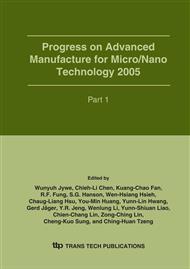[1]
N. Brahimi, S. Dauzere-Peres, N. M. Najid and A. Nordli: Single item lot sizing problems. European Journal of Operational Research 168, (2006) 1-16.
DOI: 10.1016/j.ejor.2004.01.054
Google Scholar
[2]
M. Khouja M: The single-period (news-vendor) problem: literature review and suggestions for future research. Omega-International Journal of Management Science 27, (1999) 537-553.
DOI: 10.1016/s0305-0483(99)00017-1
Google Scholar
[3]
N.C. Petruzzi and M. Dada: Pricing and the newsvendor problem: A review with extension. Operations Research 47, (1999) 183-194.
DOI: 10.1287/opre.47.2.183
Google Scholar
[4]
S.E. Elmaghraby: The economic lot scheduling problem (ELSP): Review and extensions. Management Science 24, (1978) 587-598.
DOI: 10.1287/mnsc.24.6.587
Google Scholar
[5]
C.R. Sox, P.L. Jackson, A. Bowman and J.A. Muckstadt: A review of the stochastic lot scheduling problem. Int. J. Prodction Economics 62, (1999) 181-200.
DOI: 10.1016/s0925-5273(98)00247-3
Google Scholar
[6]
M.A.A. Fawzan: An algorithm for production planning in a flexible production system. Computers and Industrial Engineering 48, (2005) 681-691.
DOI: 10.1016/j.cie.2004.12.002
Google Scholar
[7]
K.J. Chung and K.L. Hou: An optimal production run time with imperfect production processes and allowable shortages. Computers and Operations Research 30, (2003) 483-490.
DOI: 10.1016/s0305-0548(01)00091-0
Google Scholar
[8]
P.L. Abad: Optimal lot size for a perishable good under conditions of finite production and partial backordering and lost sale. Computers and Industrial Engineering 38, (2000) 457-465.
DOI: 10.1016/s0360-8352(00)00057-7
Google Scholar
[9]
M.Y. Jaber and M.K. Salameh: Optimal lot sizing under learning considerations Shortages allowed and backordered. Appl. Math. Modelling 19, (1995) 307-310.
DOI: 10.1016/0307-904x(94)00040-d
Google Scholar
[10]
L.E. Cárdenas-Barrón: The economic production quantity (EPQ) with shortage derived algebraically. Int. J. Prodction Economics 87, (2001) 289-292.
DOI: 10.1016/s0925-5273(00)00068-2
Google Scholar
[11]
D.S. Dave, K.E. Fitzpatrick and j.R. Baker: An advertising-inclusive production lot size model under continuous discount pricing. Computers ind. Engng 30, (1996) 147-159.
DOI: 10.1016/0360-8352(95)00019-4
Google Scholar
[12]
S. M. Gilbert: Coordination of pricing and multi-period production for constant priced goods. European Journal of Operational Research 114, (1999) 330-337.
DOI: 10.1016/s0377-2217(98)00042-3
Google Scholar
[13]
J. T. Teng and C. T. Chang: Economic production quantity models for deteriorating items with price- and stock-dependent demand. Computers and Operations Research 32, (2005) 297-308.
DOI: 10.1016/s0305-0548(03)00237-5
Google Scholar
[14]
P.L. Abad: Optimal pricing and lot-sizing under conditions of perishability, finite production and partial backordering and lost sale. European Journal of Operational Research 144, (2003) 677-685.
DOI: 10.1016/s0377-2217(02)00159-5
Google Scholar
[15]
J.M. Chen and L.T. Chen: Pricing and production lot-size scheduling with finite capacity for a deteriorating item over a finite horizon. Computers and Operations Research 32, (2005) 2801-2809.
DOI: 10.1016/j.cor.2004.04.005
Google Scholar


